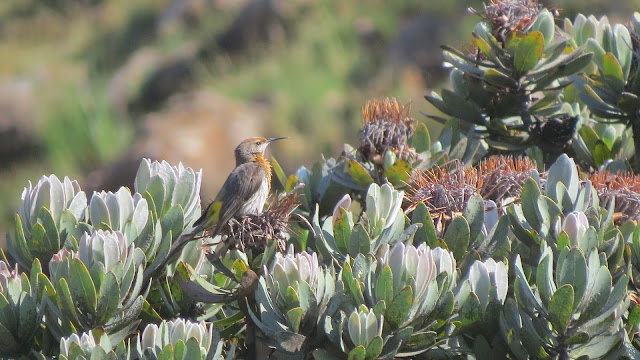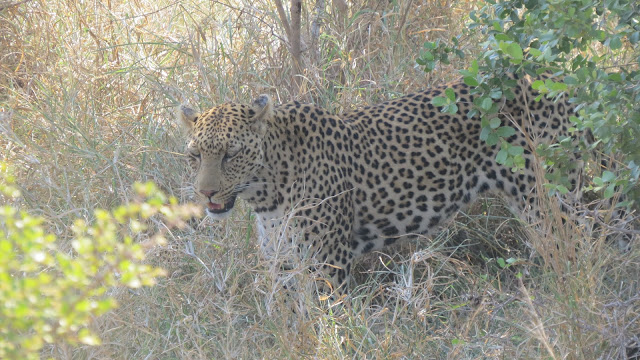Adventures in South Africa
By Luke Safford
 |
| Greater Flamingos, all photos by Luke Safford |
Years ago, maybe in 1986 or 1987, I remember visiting the Point Defiance Zoo in Tacoma, WA with my grandparents and being mesmerized by the penguin exhibit. I had never seen penguins before and I was enthralled. After plenty of time I was finally satisfied and walked off hand-in-hand with my grandma—at least I thought it was my grandma! I had been so focused on the penguins that when I finally looked up, the hand I was holding was some other older woman—not my grandma! I quickly let go and eventually found my family, but that event certainly stuck with me—I was just too focused on penguins. Ever since then I really wanted to see a penguin in the wild, and this past month I finally had the opportunity on a joint Tucson Audubon and Birding Ecotours tour to South Africa. Of course, it wasn’t just penguins, it was the whole gamut of birds and animals that as kids we only saw in zoos and our dreams—ostriches and flamingos, lions and giraffes. My oh my, this tour was certainly an adventure I’ll never forget.
Our seventeen day tour started in the lovely city of Cape Town, which is home to the African Penguin. We spent a whole morning with the penguins at Boulders Beach and witnessed them using artificial burrows for nesting. I suppose if Tucson Audubon was in Cape Town we’d be passing out penguin burrows instead of Lucy’s Warbler nestboxes!
 |
| African Penguin |
Later in the same day we explored around the Cape of Good Hope and marveled at the beauty of the fynbos shrubland habitat that dominates the landscape. Large protea plants with huge flowers attracted sunbirds and sugarbirds, reminiscent of hummingbirds. At one point, towering over the proteas and grasses, stood our first Common Ostrich of the trip. It took my breath away and I had to pinch myself to prove I wasn’t dreaming.
 |
| Common Ostrich |
The following day we boarded a small boat and prepared to head about 30-40 miles off-shore for pelagic birds like albatrosses and petrels. I learned two things:
- I’m not good at taking pictures while bouncing up and down on waves.
- Albatrosses are HUGE!
South Africa, and specifically the Western Cape hosts an amazing number of endemic, or range-restricted, bird species. One of these special birds is the Cape Rockjumper. Like its name suggests, it loves rocky hillsides, and we found a family of rockjumpers along a picturesque coastline in Rooi-Els.
 |
| Cape Rockjumper |
Our luck with endemic birds continued the next few days as we encountered Black Harrier, Victorin’s Warbler, Orange-breasted Sunbird, and Southern Black Korhaan. As we toured north along the west coast of South Africa we also paused a few times for Blue Crane, the national bird of South Africa, and the most beautiful crane I’ve ever seen.
 |
| Blue Crane |
 |
| Southern Black Korhaan |
From the coast we headed northeast into the sparsely inhabited Tankwa Karoo. The karoo is a dry, desert-like habitat that looks barren, but holds a surprising number of unique birds and wildlife. While they aren’t well known, the names of the birds paint a picture you won’t forget: Yellow-bellied Eremomela, Rufous-eared Warblers, Layard’s Tit-babblers, Pale-chanting Goshawk, Red-chested Flufftails, and Namaqua Sandgrouse.
Our return to Cape Town ended with a stop at the local “waterworks”, or sewage treatment ponds, specifically the Strandfontein Nature Preserve. While it wasn’t quite the Sweetwater Wetlands I’m used to, I was pleasantly surprised with both Greater and Lesser Flamingos—more “zoo and dream” birds that were even better seen in the wild!
The Western Cape leg of the tour wrapped up with 211 bird species seen, and now we hopped on a plane to Johannesburg for the next 10 days of birding, which included the famous and expansive Kruger National Park.
Before entering Kruger, we explored more exciting habitats including the grasslands around the small town of Dullstroom. The most exhilarating experience here was finding a pair of Cape Eagle-Owls high up in the cliffs above the lakes at the Dullstroom Nature Preserve. Later, on a night drive, we came across our first African Wild Cat, along with hearing Striped Flufftails and seeing African Grass Owl. More endemic birds followed, including a beautiful Gurney’s Sugarbird.
 |
| Gurney’s Sugarbird |
 |
| Cape Eagle-Owl |
We moved from the grasslands to a deep evergreen forest with hopes of finding Narina Trogon and Knysna Turaco, and we succeeded on both! The trogon was so similar to our Elegant Trogon and even moved about through the trees in the same stealthy way with a steady croaking. Chacma Baboons and Blue Monkeys clambering about in the trees reminded me that I wasn’t in Madera Canyon!
 |
| Narina Trogon |
By day eleven of the tour we had finally reached Kruger National Park. We were greeted by a smattering of raptors coursing over the bushveld as we waited to enter at the Phabeni Gate: White-backed Vulture, Wahlberg’s Eagle, African Hawk-Eagle, and the ever-present Bateleur.
You’ve probably heard of the “Big 5”: Cape Buffalo, African Elephant, Rhinoceros, Lion, and Leopard—we saw all of these! Each was amazing in its own right, but the mammal that really stuck with me from the beginning was the Giraffe. After entering the park, it wasn’t long before we encountered one with its neck sticking up out of the acacia trees, it was mesmerizing. We ended up seeing so many and it was no longer a “zoo or dream” animal—it was reality! We did see one Giraffe that wasn’t so magnificent looking…it was getting munched on by a Lion!
Mammals dominated the Kruger landscape and we had close encounters with many of them. We lucked out with African Wild Dogs on our very first morning, and our second day was full of Hyenas. Impala, Zebra, and Steenbok were constant along the roadside.
We also encountered 4 of the “Big 6” of African birds: Southern Ground Hornbill, Kori Bustard, Martial Eagle, and Saddle-billed Stork. The bird I most wanted to see, the Secretarybird, showed up, although it was at quite a distance. The bushveld was alive with birds as colorful as the names suggest including Purple-crested Turaco, Red-faced Mousebird, Orange-breasted Bushshrike, and Scarlet-chested Sunbird.
I was so glad to have an experienced guide with us throughout the tour. Dylan Vasapoli of Birding Ecotours was the most patient and professional guide I’ve ever worked with and his knowledge of South African birds seemed unparalleled. He helped us separate Brubrus from Boubous, Robin-Chats from Scrub Robins, and Prinias from Cisticolas. I would have been a helpless mess without him.
 |
| Red-backed Scrub Robin |
 |
| Southern Ground Hornbill |
One last story from Kruger. The light was just beginning to show itself early in the morning of our first day at Satara Camp when I went outside. I was enjoying the cool air when I looked out across the field and noticed a somewhat large animal scurrying around. I stepped off the porch to see what it was and saw that it was dark with a big white stripe going down its back—Honey Badger! At first I was thinking what a cool sight this was, but then my mind raced as it came towards me at a high speed…what is it doing? It kept coming closer and I shuffled back to my porch area and finally blurted out something of a scream/yell…then it ran off away from me. A little too close to comfort—I think those things are vicious, or so I’ve heard. Fuzzy, out of focus pictures, is all I have of the memory to share. Maybe I should have stood my ground.
 |
| Honey Badger blur |
After leaving the Kruger NP, we spent our last evening and morning at the luxurious Zenzele River Lodge. A morning of Crimson-breasted Gonoleks, Red-chested Cuckoos, Arrow-marked Babblers, and Yellow-fronted Tinkerbirds was a lovely way to close up the tour. Rooms right on the river proved to be peaceful, despite signs warning us of hippos and crocodiles.
 |
| Zenzele River Lodge |
We ended the tour with 413 bird species on our trip list, along with 50 mammals and 19 reptiles/amphibians. The whole trip would not have been possible without Birding Ecotours and our guide Dylan Vasapoli who organized everything, drove hundreds of miles, and graciously answered all of our questions—bird and non-bird related! If you have the opportunity you should check out the Birding Ecotours website and consider joining them on a future trip.
Speaking of future trips, we do have a few Tucson Audubon international tours in the works with partner tour companies, including Birding Ecotours. Check our field trip page for updates and check your email inbox as well if you are on our email list. I hope you’re able to join us and fulfill a childhood dream or two of your own!
Luke Safford is Tucson Audubon's Director of Engagement and Education.





Comments
Post a Comment
Thanks, we value your opinions! Your comment will be reviewed before being published.